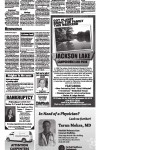ThisWeek CW 06/30/2011
The Canal Winchester Landmarks Commission spent much of its time June 27 discussing the kinds of building materials that can be used in renovation and maintenance projects in the city’s preservation and historic districts.
Members approved a request from John Stedman, who plans to move Village Wines and Bistro from its current location on West Waterloo Street to 10 S. High St. downtown. He requested approval of an outdoor patio area in the front of the building, patio fencing, plantings to screen patrons from street noise and two new exterior doors — one for patio access and another as an emergency egress for the dining room.
“Our goal was to stick with stainless steel wire fencing, to stick with the style of the building,” Stedman said.
Commissioner Will Bennett quoted a passage from the district guidelines that says all front yard fences must be either wood picket or wrought iron.
Planning commission member Bruce Jarvis said the mid-century building on South High Street isn’t considered historically significant, although it is intact as it was originally designed.
“It’s fairly intact and was built as a modern, mid-century style building, but it never fit the character of the village,” Jarvis said. “I don’t feel there is anything architecturally significant that these plans would destroy or lose for future generations.
“The Preservation Area guidelines require maintaining styles, but this is an exception from the beginning because of the era it was built, so doing something industrial around it is only fitting, due to the context of this property,” he said. “If you put a Victorian-era fence around it, that wouldn’t look right. I’m just worried that someone else would want to do this around a different (era) building, using this as a precedent, and I wouldn’t agree with that.”
According to commissioner Patrick Lynch, the building was originally occupied by the Midland (South Central) Power Co., which had signs along the roofline of the building and aluminum accents along the soffit of the building and windows and doorframes.
“This commission’s duty is to determine what’s appropriate,” Lynch said. “I don’t think we’re setting a precedent for the whole neighborhood, just for this particular building. There’s a lot of aluminum across the building itself.”
Discussion about signage also centered on maintaining the historic look of the building. Bennett asked how the bistro’s signs would be applied to the building.
“Nothing has been decided yet, but looking at the original blueprints for the building, we saw the sign was individual letters on the roof, so we talked about emulating that,” Stedman said.
City planning and zoning administrator Andrew Dutton pointed out that a zoning variance would be required due to restrictions on load-bearing structures such as roofs and possible issues with signage size requirements.
Jarvis said he thought preserving the look of the original signage would be worthwhile.
“We’re prepared to request a variance,” Stedman said. “We’ll have to do it soon, in the next couple of weeks. We hope to be open by Halloween.”
The Landmarks Commission tabled action on a request from Don Hartman Tires to replace rotted wood with concrete fiberboard due to questions about what part of the building was being repaired. No representative for the applicant was present to answer the questions and commission members said the information in the application was not clear.
However, even without the applicant on hand, commission members had a lengthy discussion about whether concrete fiberboard could be used to replace wood in the Historic District without an application submission to the Landmarks Commission.
According to Lynch, maintenance of original materials is acceptable per the preservation guidelines, and there is precedent for accepting concrete fiberboard as an acceptable replacement for wood.
“If it were wood for wood, then (Don Hartman Tires) wouldn’t need an application,” Dutton said. “Since the guidelines don’t actually say, (concrete fiberboard) is an acceptable replacement.”
Dutton said the city continues to work to revise its zoning documents, including codifying portions of the preservation guidelines. These design standards will become non-negotiable while the remaining guidelines will still have some flexibility, he said.
The next Landmarks Commission meeting is scheduled for 7 p.m., Monday, July 25, at Town Hall, 10 N. High St

